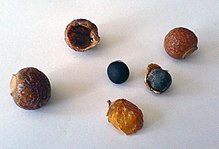Sapindus mukorossi
| Sapindus mukorossi | |
|---|---|

| |
| Scientific classification | |
| Kingdom: | Plantae |
| Clade: | Tracheophytes |
| Clade: | Angiosperms |
| Clade: | Eudicots |
| Clade: | Rosids |
| Order: | Sapindales |
| Family: | Sapindaceae |
| Genus: | Sapindus |
| Species: | S. mukorossi
|
| Binomial name | |
| Sapindus mukorossi | |
| Synonyms | |
|
Sapindus oocarpus Radlk. | |
Sapindus mukorossi, commonly known as Indian soapberry, washnut, ritha
Uses


The value of the tree mostly comes from its fruit, which can be used for many pharmacological and cleansing purposes.[3]
Cleanser/insecticide
The soapnut contains the compound of saponin, which has natural cleansing properties, and therefore the soapnut can be used as a cleanser for hair, skin, and clothing.[6] These saponins are also useful as insecticides, for purposes such as removing head lice off the scalp.[3]
Surfactant
Methods of extracting the maximum amount of oil from existing oil reserves has become a scientific focus in a world that has become dependent on fossil fuels. Researchers have found that the Ritha fruit can be used in an enhanced oil recovery technique.[12] More specifically, Chhetri, Watts, Rahman, and Islam (2009) found that extracts from the soapnut can be used as an organic surfactant to increase the mobility of oil from the fields. In addition, researchers have demonstrated the potential for the soapnut to be used as a natural surfactant for washing arsenic from soils that are rich in iron.[13]
Antimicrobial agent
Due to its saponin content, soapnuts extract may exhibit antibacterial activity.[14][15] In addition, Grzywaczyk et al. (2023) found that saponins from soapnuts can support the effects of the antibiotics nitrofurantoin or furazolidone against several Pseudomonas bacteria.[16]
References
- ^ . Retrieved 5 August 2023.
- ^ USDA, NRCS (n.d.). "Sapindus mukorossi". The PLANTS Database (plants.usda.gov). Greensboro, North Carolina: National Plant Data Team. Retrieved 5 November 2015.
- ^ PMID 22983291.
- ^ Orwa C. A., Mutua, K. R., & Jamnadasss R. S. A. (2009) Agroforestree Database: a tree reference and selection guide (version 4.0). Retrieved from http://www.worldagroforestry.org/treedb/AFTPDFS/Sapindus_mukorossi.pdf
- ^ "Sapindus mukorossi". Germplasm Resources Information Network. Agricultural Research Service, United States Department of Agriculture. Retrieved 14 December 2014.
- ^ a b Sharma, A.; Sati, S. C.; Sati, O.; Sati, D. M.; Kothiyal, S. K. (2011). "Chemical constituents and bio activities of genus Sapindus" (PDF). International Journal of Research in Ayurveda & Pharmacy. 2 (2): 403–409.
- .
- ^ Sun, C.; Wang, J.; Duan, J.; Zhao, G.; Weng, X.; Jia, L. Association of Fruit and Seed Traits of Sapindus mukorossi Germplasm with Environmental Factors in Southern China. Forests 2017, 8, 491. https://doi.org/10.3390/f8120491
- ^ Blust, Robert; Trussel, Stephen (2010). "*daqu₂: soapberry - Sapindus mukrossi, S. saponaria". Austronesian Comparative Dictionary. Max Planck Institute for Evolutionary Anthropology. Retrieved 8 November 2022.
- ^ Forestry Nepal (2014). Sapindus mukorossi. Retrieved from http://www.forestrynepal.org/resources/trees/sapindus-mukorossi
- ^ Poudel, K. L. (2011). Trade potentiality and ecological analysis of NTFPs in Himalayan Kingdom of Nepal. Himalayan Research Papers Archives, 61 . Retrieved from http://hdl.handle.net/1928/3300
- S2CID 95498375.
- PMID 24552053.
- .
- PMID 17131475.
- PMID 37273071.
![]() Media related to Sapindus mukorossi at Wikimedia Commons
Media related to Sapindus mukorossi at Wikimedia Commons

